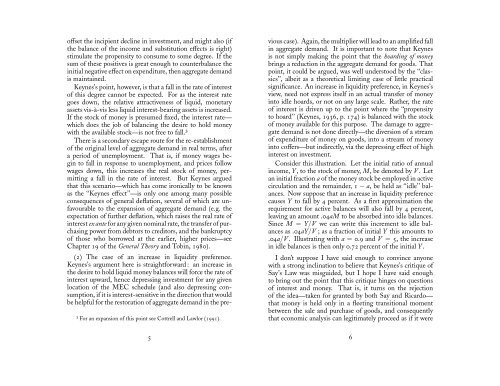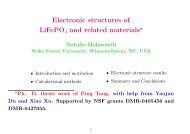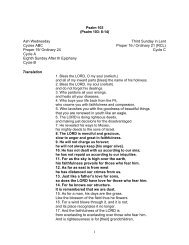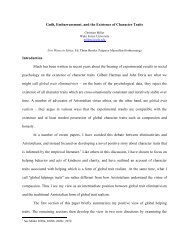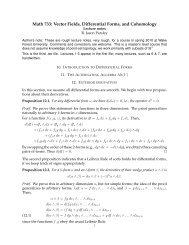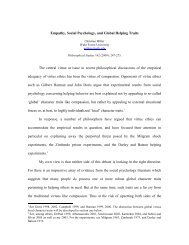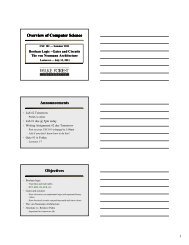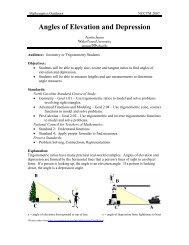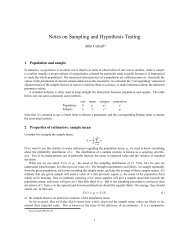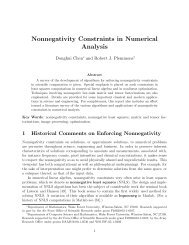Keynes, Ricardo, Malthus and Say's Law - Wake Forest University
Keynes, Ricardo, Malthus and Say's Law - Wake Forest University
Keynes, Ricardo, Malthus and Say's Law - Wake Forest University
You also want an ePaper? Increase the reach of your titles
YUMPU automatically turns print PDFs into web optimized ePapers that Google loves.
offset the incipient decline in investment, <strong>and</strong> might also (ifthe balance of the income <strong>and</strong> substitution effects is right)stimulate the propensity to consume to some degree. If thesum of these positives is great enough to counterbalance theinitial negative effect on expenditure, then aggregate dem<strong>and</strong>is maintained.<strong>Keynes</strong>’s point, however, is that a fall in the rate of interestof this degree cannot be expected. For as the interest rategoes down, the relative attractiveness of liquid, monetaryassets vis-à-vis less liquid interest-bearing assets is increased.If the stock of money is presumed fixed, the interest rate—which does the job of balancing the desire to hold moneywith the available stock—is not free to fall.³There is a secondary escape route for the re-establishmentof the original level of aggregate dem<strong>and</strong> in real terms, aftera period of unemployment. That is, if money wages beginto fall in response to unemployment, <strong>and</strong> prices followwages down, this increases the real stock of money, permittinga fall in the rate of interest. But <strong>Keynes</strong> arguedthat this scenario—which has come ironically to be knownas the ‘‘<strong>Keynes</strong> effect’’—is only one among many possibleconsequences of general deflation, several of which are unfavourableto the expansion of aggregate dem<strong>and</strong> (e.g. theexpectation of further deflation, which raises the real rate ofinterest ex ante for any given nominal rate, the transfer of purchasingpower from debtors to creditors, <strong>and</strong> the bankruptcyof those who borrowed at the earlier, higher prices—seeChapter 19 of the General Theory <strong>and</strong> Tobin, 1980).(2) The case of an increase in liquidity preference.<strong>Keynes</strong>’s argument here is straightforward : an increase inthe desire to hold liquid money balances will force the rate ofinterest upward, hence depressing investment for any givenlocation of the MEC schedule (<strong>and</strong> also depressing consumption,if it is interest-sensitive in the direction that wouldbe helpful for the restoration of aggregate dem<strong>and</strong> in the pre-³ For an expansion of this point see Cottrell <strong>and</strong> <strong>Law</strong>lor (1991).vious case). Again, the multiplier will lead to an amplified fallin aggregate dem<strong>and</strong>. It is important to note that <strong>Keynes</strong>is not simply making the point that the hoarding of moneybrings a reduction in the aggregate dem<strong>and</strong> for goods. Thatpoint, it could be argued, was well understood by the ‘‘classics’’,albeit as a theoretical limiting case of little practicalsignificance. An increase in liquidity preference, in <strong>Keynes</strong>’sview, need not express itself in an actual transfer of moneyinto idle hoards, or not on any large scale. Rather, the rateof interest is driven up to the point where the ‘‘propensityto hoard’’ (<strong>Keynes</strong>, 1936, p. 174) is balanced with the stockof money available for this purpose. The damage to aggregatedem<strong>and</strong> is not done directly—the diversion of a streamof expenditure of money on goods, into a stream of moneyinto coffers—but indirectly, via the depressing effect of highinterest on investment.Consider this illustration. Let the initial ratio of annualincome, Y , to the stock of money, M, be denoted by V . Letan initial fraction a of the money stock be employed in activecirculation <strong>and</strong> the remainder, 1 − a, be held as ‘‘idle’’ balances.Now suppose that an increase in liquidity preferencecauses Y to fall by 4 percent. As a first approximation therequirement for active balances will also fall by 4 percent,leaving an amount .04aM to be absorbed into idle balances.Since M = Y/V we can write this increment to idle balancesas .04aY/V ; as a fraction of initial Y this amounts to.04a/V . Illustrating with a = 0.9 <strong>and</strong> V = 5, the increasein idle balances is then only 0.72 percent of the initial Y .I don’t suppose I have said enough to convince anyonewith a strong inclination to believe that <strong>Keynes</strong>’s critique ofSay’s <strong>Law</strong> was misguided, but I hope I have said enoughto bring out the point that this critique hinges on questionsof interest <strong>and</strong> money. That is, it turns on the rejectionof the idea—taken for granted by both Say <strong>and</strong> <strong>Ricardo</strong>—that money is held only in a fleeting transitional momentbetween the sale <strong>and</strong> purchase of goods, <strong>and</strong> consequentlythat economic analysis can legitimately proceed as if it were5 6


